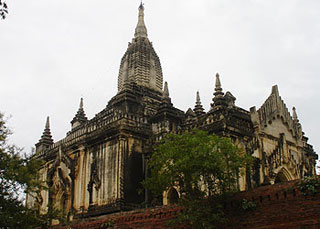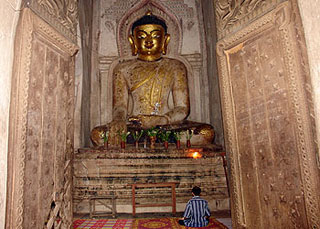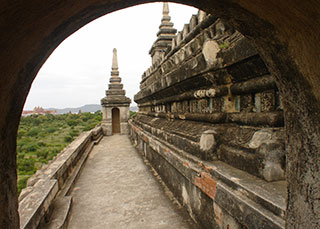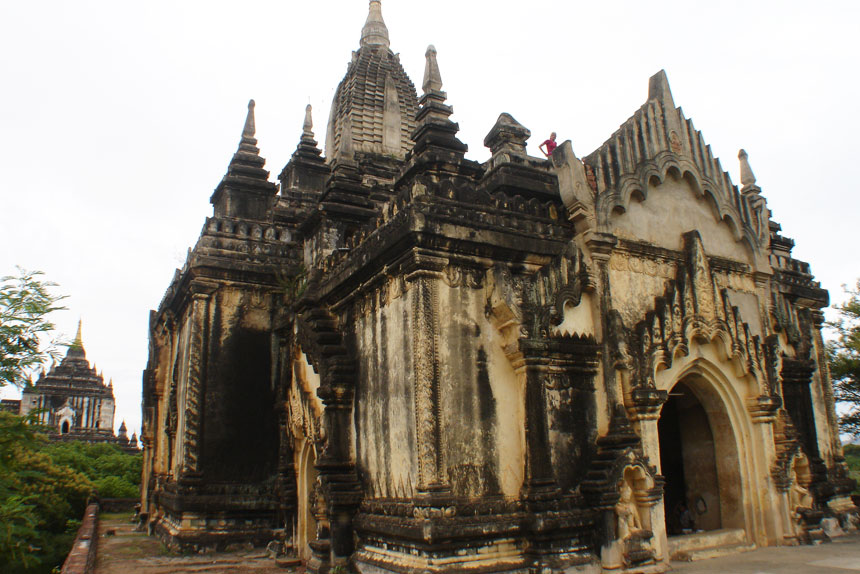Shwegugyi Pagoda was built by King Alaung Sithu during A.D 1141. This pagoda is located near the entrance of the Royal Palace therefore also known as Nan Oo Paya in Myanmar. Shwegugyi Pagoda was built on top of a 13 feet high platform giving it an impression like a mushroom coming out of the ground. It is facing towards the north of Bagan. It lies on the north of Thabyinnyu Pagoda.


It is a cave Pagoda with a Sikhara on the top facing north. The wall of the brick plinth was adorned with glazed tiles of green color. There used to be plaster moldings presenting Deva figures in row. But now only three remain on the southern side. At the north- west corner of the chamber there is a stone stairway leading to the top. All along the base of the pagoda and the terraces are found decorative glazed tiles of green color. still in good condition.
Inside the image house. four Buddha images of brick and cement backing one another are seated around the central pillar. There are two inscribed stone slabs inlaid in the wall of the northern entrance.
Inscription
The inscription is in Pali. one slab has 47 lines and the other 45. They are Pali poem of 100 stanzas. At the end of the poem are two lines of Sanskrit. The inscription mentions the beginning and completion dates of the construction of the Pagoda. So we learn from it that it took 7 months and 7 days to build the Pagoda.
The last two lines in Sanskrit run as follows;
“The construction began on Sunday the 4th waning moon of Kason month in the Sakarit year 503 and Shwegugyi Pagoda was completed successfully on Monday the 11th waning moon of Nataw month in the Sakarit year 503. “
The inscription also mentions the regional title of King Alaung Sithu as
” Thihtibuvanaditya pavara dhammaraja”.
The inscription says that the king built this pagoda because he wished to attain Nirvana and that the king sought after the noble virtues. that he strove to become Buddha himself and that he took refuge in three Gems (The Buddha. the Dhamma and the Sangha). The inscription continues to mention the king’s wishes — he prayed that he would like to do the welfare of himself and of others. he would like to return the debt of gratitude whomsoever he owed he would like to save the sentient beings from the sufferings of the birth cycle (Samsara) and just like Miteya the future Buddha the king would like to become the one much worshipped and adored by humans and divas. There are plaster works of floral designs. intricate ornamental backdrops and other stuccos adorning the central pillar. In each of the devotional halls on the north. south. and west sides are two statues of Duara-pala deva. one leg up and the other leg down. At each of the four sides of the main building are two windows to let in the breeze. totally 6 windows in all. These are original artworks.
On the north-western corner of the pagoda is a small stone staircases leading up to the other levels. Shwegugyi pagoda was constructed between the early and mid Bagan periods. The architectural design of this monument is formed into a place of good lighting and ventilation. There are statues of nats around the platform of the pagoda. There is a great masonry work inside. but decorated with glazed greenish coloured plaques from the outside. There are about 20 pagodas with Bagan style glazed plaques and Shwegugyi represents one of those monuments. In the main hall of the pagoda lies the two original stone inscriptions of the Pagoda. There are also poems and phrases on the walls of the pagoda.


Wood carving
At the devotional halls on the east. west. and south sides and the vaulted corridor joining the main building are the big wooden door leaves dedicated by King Bayint Naung (A.D. 1551—81) who renovated Shwegugyi Pagoda. during his pilgrimage there. On the door leaves are found beautiful carvings of birds. On the east side only one door leaf survives.
Mural painting
The original fresco on the walls of the main building are visible but only faintly owing to lime wash over .them. After chemical cleaning they will appear in their original colors. The paintings above the great Buddha Image in the northern image house belong to the Kon Baung Period. There are 13 lines of ink inscription of the same period found on the wall left side of the .said image. Myanmar chronicles say that King Alaung Sithu. being seized by illness in his old age. was moved to this Pagoda where he died. King Bayint Naung. the “founder of the second Myanmar Empire renovated and embellished Shwegugyi Pagoda in the Sakarit year 913 (A.D. 1551). He also set up a stone pillar at the south-west corner of the devotional hall. It bears eleven lines of inscription. dated Sakarit year 913. The inscription says that; ” When the king’s elder brother became king. he repaired and built monasteries and monuments in his kingdom. He let the tax collectors levy only normal rate. Should they overtax. they are destroying Buddha Sasana. as well as persecuting the public. the clergy and laymen.”

